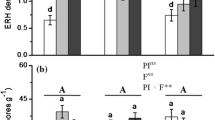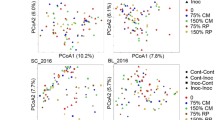Abstract
The effect of manure and mineral fertilization on the arbuscular mycorrhizal (AM) fungal community structure of sunflower (Helianthus annuus L.) plants was studied. Soils were collected from a field experiment treated for 12 years with equivalent nitrogen (N) doses of inorganic N, dairy manure slurry, or without N fertilization. Fresh roots of tall fescue (Festuca arundinacea Schreb.) grass collected from the field plots without N fertilization and unfumigated field soils were used as native microbial inoculum sources. Sunflower plants were sown in pots containing these soils, and three different means of manipulating the microbial community were set: unfumigated soil with fresh grass roots, fumigated soil with fresh grass roots, or fumigated soil with sterilized grass roots. Assessing the implications with respect to plant productivity and mycorrhizal community structure was investigated. Twelve AM fungal OTUs were identified from root or soil samples as different taxa of Acaulospora, Claroideoglomus, Funneliformis, Rhizophagus, and uncultured Glomus, using PCR-DGGE and sequencing of an 18S rRNA gene fragment. Sunflower plants grown in manure-fertilized soils had a distinct AMF community structure from plants either fertilized with mineral N or unfertilized, with an abundance of Rhizophagus intraradices-like (B2). The results also showed that AM inoculation increased P and N contents in inorganic N-fertilized or unfertilized plants, but not in manure-fertilized plants.





Similar content being viewed by others
References
Adesemoye A, Kloepper J (2009) Plant–microbes interactions in enhanced fertilizer-use efficiency. Appl Microbiol Biotechnol 85:1–12
An ZQ, Guo BZ, Hendrix JW (1993) Populations of spores and propagules of mycorrhizal fungi in relation to the life cycles of tall fescue and tobacco. Soil Biol Biochem 25:813–817
Beauregard M-S, Hamel C, Nayyar A, St-Arnaud M (2010) Long-term phosphorus fertilization impacts soil fungal and bacterial diversity but not AM fungal community in alfalfa. Microb Ecol 59:379–389
Bhadalung NN, Suwanarit A, Dell B, Nopamornbodi O, Thamchaipenet A, Rungchuang J (2005) Effects of long-term NP-fertilization on abundance and diversity of arbuscular mycorrhizal fungi under a maize cropping system. Plant Soil 270:371–382
Bobbink R (1991) Effects of nutrient enrichment in Dutch chalk grassland. J Appl Ecol 28:28–41
Börjesson G, Menichetti L, Kirchmann H, Kätterer T (2012) Soil microbial community structure affected by 53 years of nitrogen fertilization and different organic amendments. Biol Fertil Soils 48:245–257
Chaparro JM, Sheflin AM, Manter DK, Vivanco JM (2012) Manipulating the soil microbiome to increase soil health and plant fertility. Biol Fertil Soils 48:489–499
Covacevich F, Echeverría HE (2009) Mycorrhizal occurrence and responsiveness of tall fescue and wheatgrass are affected by the source of phosphorus fertilizer and fungal inoculation. J Plant Interac 4:101–112
Cruz C, Green JJ, Watson CA, Wilson F, Martins-Loução MA (2004) Functional aspects of root architecture and mycorrhizal inoculation with respect to nutrient uptake capacity. Mycorrhiza 14:177–184
Egerton-Warburton LM, Allen EB (2000) Shifts in arbuscular mycorrhizal communities along an anthropogenic nitrogen deposition gradient. Ecol Appl 10:484–496
Ellouze W, Hamel C, Bouzid S, St-Arnaud M (2011) Mycorrhizosphere interactions mediated through rhizodepositions and arbuscular mycorrhizal hyphodeposition and their application in sustainable agriculture. In: Fulton SM (ed) Mycorrhizal fungi: soil, agriculture and environmental implications. Nova, Hauppauge, pp 133–152
Fenn M, Poth M, Aber J, Baron J, Bormann B, Johnson D, Lemly A, McNulty S, Ryan D, Stottlemyer R (1998) Nitrogen excess in North American ecosystems: predisposing factors, ecosystem responses, and management strategies. Ecol Appl 8:706–733
Giovannetti M, Mosse B (1980) An evaluation of techniques for measuring vesicular arbuscular mycorrhizal infection in roots. New Phytol 84:489–500
Gryndler M, Larsen J, Hršelová H, Řezáčová V, Gryndlerová H, Kubát J (2006) Organic and mineral fertilization, respectively, increase and decrease the development of external mycelium of arbuscular mycorrhizal fungi in a long-term field experiment. Mycorrhiza 16:159–166
Gyaneshwar P, Naresh Kumar G, Parekh LJ, Poole PS (2002) Role of soil microorganisms in improving P nutrition of plants. Plant Soil 245:83–93
Hassan SED, Boon E, St-Arnaud M, Hijri M (2011) Molecular biodiversity of arbuscular mycorrhizal fungi in trace metal-polluted soils. Mol Ecol 20:3469–3483
Helgason T, Daniell TJ, Husband R, Fitter AH, Young JPW (1998) Ploughing up the wood-wide web? Nature 394:431–431
Joergensen R, Mäder P, Fließbach A (2010) Long-term effects of organic farming on fungal and bacterial residues in relation to microbial energy metabolism. Biol Fert Soils 46:303–307
Johnson D, Vandenkoornhuyse PJ, Leake JR, Gilbert L, Booth RE, Grime JP, Young JPW, Read DJ (2003) Plant communities affect arbuscular mycorrhizal fungal diversity and community composition in grassland microcosms. New Phytol 161:503–515
Johnson NC (1993) Can fertilization of soil select less mutualistic mycorrhizae? Ecol Appl 3:749–757
Joner EJ (2000) The effect of long-term fertilization with organic or inorganic fertilizers on mycorrhiza-mediated phosphorus uptake in subterranean clover. Biol Fert Soils 32:435–440
Jumpponen A, Trowbridge J, Mandyam K, Johnson L (2005) Nitrogen enrichment causes minimal changes in arbuscular mycorrhizal colonization but shifts community composition—evidence from rDNA data. Biol Fert Soils 41:217–224
Koch AM, Croll D, Sanders IR (2006) Genetic variability in a population of arbuscular mycorrhizal fungi causes variation in plant growth. Ecol Lett 9:103–110
Kowalchuk GA, de Souza FA, van Veen JA (2002) Community analysis of arbuscular mycorrhizal fungi associated with Ammophila arenaria in Dutch coastal sand dunes. Mol Ecol 11:571–581
Lecomte J, St-Arnaud M, Hijri M (2011) Isolation and identification of soil bacteria growing at the expense of arbuscular mycorrhizal fungi. FEMS Microbiol Lett 317:43–51
Lioussanne L, Perrault F, Jolicoeur M, St-Arnaud M (2010) The bacterial community of tomato rhizosphere is modified by inoculation with arbuscular mycorrhizal fungi but unaffected by soil enrichment with mycorrhizal root exudates or inoculation with Phytophthora nicotianae. Soil Biol Biochem 42:473–483
Mäder P, Vierheilig H, Streitwolf-Engel R, Boller T, Frey B, Christie P, Wiemken A (2000) Transport of 15N from a soil compartment separated by a polytetrafluoroethylene membrane to plant roots via the hyphae of arbuscular mycorrhizal fungi. New Phytol 146:155–161
Munkvold L, Kjøller R, Vestberg M, Rosendahl S, Jakobsen I (2004) High functional diversity within species of arbuscular mycorrhizal fungi. New Phytol 164:357–364
Öpik M, Moora M, Liira J, Zobel M (2006) Composition of root-colonizing arbuscular mycorrhizal fungal communities in different ecosystems around the globe. J Ecol 94:778–790
Porras-Alfaro A, Herrera J, Natvig D, Sinsabaugh R (2007) Effect of long-term nitrogen fertilization on mycorrhizal fungi associated with a dominant grass in a semiarid grassland. Plant Soil 296:65–75
Read AF, Taylor LH (2001) The ecology of genetically diverse infections. Science 292:1099–1102
Rosenzweig M (1995) Species diversity in space and time. Cambridge University Press, Princeton
Saitou N, Nei M (1987) The neighbor-joining method: a new method for reconstructing phylogenetic trees. Mol Biol Evol 4:406–425
Santos JC, Finlay RD, Tehler A (2006) Molecular analysis of arbuscular mycorrhizal fungi colonising a seminatural grassland along a fertilization gradient. New Phytol 172:159–168
Sasvári Z, Hornok L, Posta K (2011) The community structure of arbuscular mycorrhizal fungi in roots of maize grown in a 50-year monoculture. Biol Fertil Soils 47:167–176
Scheublin TR, Sanders IR, Keel C, van der Meer JR (2010) Characterisation of microbial communities colonising the hyphal surfaces of arbuscular mycorrhizal fungi. ISME J 4:752–763
Smith SE, Read DJ (2008) Mycorrhizal symbiosis. Academic, London
St-Arnaud M, Vujanovic V (2007) Effect of the arbuscular mycorrhizal symbiosis on plant diseases and pests. In: Hamel C, Plenchette C (eds) Mycorrhizae in crop production. Haworth Press, Binghampton, pp 67–122
Tamura K, Dudley J, Nei M, Kumar S (2007) MEGA4: Molecular Evolutionary Genetics Analysis (MEGA) Software Version 4.0. Mol Biol Evol 24:1596–1599
Toljander JF, Santos-González JC, Tehler A, Finlay RD (2008) Community analysis of arbuscular mycorrhizal fungi and bacteria in the maize mycorrhizosphere in a long-term fertilization trial. FEMS Microbiol Ecol 65:323–338
Tu C, Booker FL, Watson DM, Chen X, Rufty TW, Shi W, Hu S (2006) Mycorrhizal mediation of plant N acquisition and residue decomposition: Impact of mineral N inputs. Glob Change Biol 12:793–803
van der Heijden MGA, Klironomos JN, Ursic M, Moutoglis P, Streitwolf-Engel R, Boller T, Wiemken A, Sanders IR (1998) Mycorrhizal fungal diversity determines plant biodiversity, ecosystem variability, and productivity. Nature 396:69–72
Verma RK, Arya ID (1998) Effect of arbuscular mycorrhizal fungal isolates and organic manure on growth and mycorrhization of micropropagated Dendrocalamus asper plantlets and on spore production in their rhizosphere. Mycorrhiza 8:113–116
Vierheilig H, Coughlan AP, Wyss U, Piche Y (1998) Ink and vinegar: a simple staining technique for arbuscular-mycorrhizal fungi. Appl Environ Microbiol 64:5004–5007
Vivas A, Biro B, Nemeth T, Barea JM, Azcon R (2006) Nickel-tolerant Brevibacillus brevis and arbuscular mycorrhizal fungus can reduce metal acquisition and nickel toxicity effects in plant growing in nickel-supplemented soil. Soil Biol Biochem 38:2694–2704
Wang M-Y, Hu L-B, Wang W-H, Liu S-T, Li M, Liu R-J (2009) Influence of long-term fixed fertilization on diversity of arbuscular mycorrhizal fungi. Pedosphere 19:663–672
White TJ, Bruns TD, Lee SB, White TJ (1990) Amplification and direct sequencing of fungal ribosomal RNA genes for phylogenetics. In: Innis MA, Gelfand DH, Sninsky JJ, White TJ (eds) PCR protocols: A guide to methods and applications. Academic, San Diego, pp 315–322
Yergeau E, Vujanovic V, St-Arnaud M (2006) Changes in communities of fusarium and arbuscular mycorrhizal fungi as related to different asparagus cultural factors. Microb Ecol 52:104–113
Acknowledgments
This work was supported by NSERC discovery grants to both MSA and MH and by a fellowship from the Ministry of Higher Education of Egypt to SEH, to which supports are gratefully acknowledged. Funding was also provided by NSERC Metal in the Human Environment (MITHE) grant. We thank Stéphane Daigle for helping with statistical analysis and Cristina Micali for comments and English editing.
Author information
Authors and Affiliations
Corresponding authors
Rights and permissions
About this article
Cite this article
Hassan, S.E.D., Liu, A., Bittman, S. et al. Impact of 12-year field treatments with organic and inorganic fertilizers on crop productivity and mycorrhizal community structure. Biol Fertil Soils 49, 1109–1121 (2013). https://doi.org/10.1007/s00374-013-0813-7
Received:
Revised:
Accepted:
Published:
Issue Date:
DOI: https://doi.org/10.1007/s00374-013-0813-7




